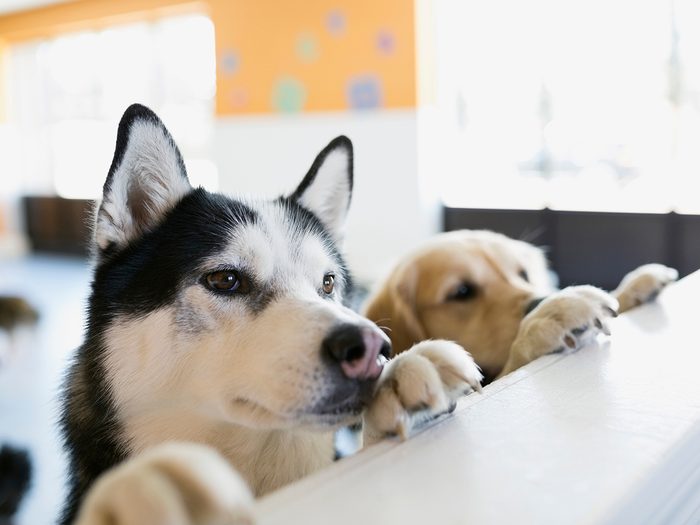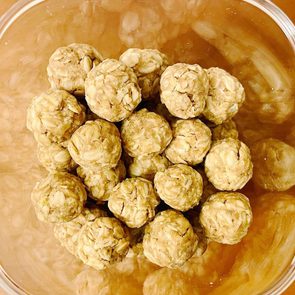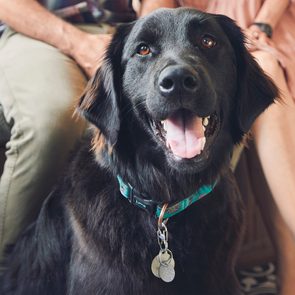A List of Foods Dogs Can’t Eat—And How to React If They Do, According to Vets

Pups are passionate snackers, but sharing “people food” takes some pet parenting know-how. Licensed veterinarians share what you should know about tempting your dog’s tastebuds with the foods we eat ourselves.
Most dogs will eat just about anything—and if you have one, you know they’re particularly interested in anything their favourite humans are eating (as the wet nose nudging your elbow at the dinner table will eagerly remind you). But just because a dog wants to eat something doesn’t mean they should.
Obviously you can’t trust your pet’s judgment about their own diet, and getting educated about what your dog can and can’t eat is Pet Parenthood 101, says Efrem Hunter, DVM, MBA, a veterinarian and director of Veterinary and Scientific Affairs at Blue Buffalo.
Why it’s important to pay attention to your dog’s food
Who can resist those big eyes begging for just a nibble of whatever you’re having? You. It’s not easy, but it’s important.
Veterinarian Jacqueline Brister, DVM, a consultant for Embrace Pet Insurance, explains that it’s practical, too: “Feeding your dog only healthy foods saves on veterinary bills as some treatments for food toxicity can be very time consuming, involving round-the-clock care, and thus can be quite costly.”
Do dogs benefit from a varied diet?
Dog food made by a reputable company is scientifically designed to provide balanced and complete nutrition, and a dog can do quite well with that as their primary food, Dr. Hunter says.
There is no nutritional need to feed dogs extras, like fruit or veggies, but occasionally switching up a dog’s diet can have other perks, says Barbara Hodges, DVM, the director of advocacy and outreach for the Humane Society Veterinary Medical Association. This is one of the biggest points she brings up with clients: “I ask them to imagine if we ate the same thing every day all our lives,” says Dr. Hodges.
Not fun, right? Your four-legged friend might agree. “Variety really is the spice of life,” she says. “I don’t believe people tend to sit down and calculate the precise nutritional value of each meal. In general, we eat because we like the taste of things. Dogs are not different.”
How human food can hurt dogs
Certain foods can make our pets sick. “Not all human food agrees with our furry friends because they have different digestive systems, nutritional needs, and metabolisms,” Dr. Hunter says.
He adds that common offenders include lactose (the natural sugar in dairy products), fructose (the sugar in fruit), and simple carbs, like flour. While these might not seriously harm your pup, they can cause bloating, discomfort, and pain—especially when eaten frequently or in large amounts.
Next are the red-flag foods that can cause your dog to get sick or seriously ill. These foods contain compounds that might not be threats to us humans, but they can damage or destroy healthy cells in your pooch’s body. One lesser-known toxin for dogs is the apple seed, which contain cyanide, which can be poisonous.
All pet owners should know about the normal-for-people foods that are so toxic that even small amounts can cause death without treatment. These include grapes or raisins for some dog breeds, products that contain even the tiniest amounts of the sweetener xylitol (sometimes now referred to by other sneaky names such as “birch sugar”), and certain types of chocolate, Dr. Brister explains.
Beyond ingredients, there are a few other ways foods can create trouble for dogs. For instance, you may have noticed that your dog isn’t the best chewer when they’re excited—many dogs gulp or swallow food while little or no chewing. So while the food may not be toxic to dogs, it can pose a choking hazard.
Our experts explain that larger dogs tend to be able to digest more of, or safely swallow, some foods or parts of foods smaller dogs cannot. Some dogs have a naturally smaller or more narrow esophagus, which means they may have trouble swallowing the same food portions other dogs can safely eat.
Just as a few examples, this is true with hard or large table scraps, gristle, or bone. In some cases, dogs can choke on the seeds or stones of certain fruits, such as cherries, plums, peaches, nectarines, mangoes. Other foods may contain sharp parts (think spikes and stems) that can damage the throat or other parts of the digestive tract.
And know that even if your dog manages to completely swallow a bone, rind, or large pit without trouble, it can cause intestinal blockages which require immediate surgery, say our docs.
Foods dogs can safely eat
A majority of foods are safe for dogs in moderation and with proper preparation.
Ask your vet about a particular snack you might be curious about sharing with your dog. Generally safe human foods for dogs include:
- Strawberries, raspberries and blackberries
- Bananas
- Apples
- Melons, including watermelon and cantaloupe
- Pineapple
- Cucumber
- Mango
- Peaches, pears, plums, and nectarines
- Broccoli and cauliflower
- Brussels sprouts
- Carrots
- Green beans and peas
- Leafy greens
- Grains, cereals, and pulses (like chickpeas)
- Bread
- Mild cheeses
- Corn and popcorn (but do not let your dog get hold of a corn cob, as this can cause a serious blockage in their digestive system and possibly turn life-threatening)
- Peanut butter
- Honey
- Yogurt
Foods dogs cannot eat
Organizations such as the Humane Society of the United States provide lists of foods that are not safe for dogs to consume. Some of the most common foods that can be dangerous for dogs to eat, or that can contribute to health complications, include:
- Grapes, raisins, and currants
- Onion, leek, and chives
- Garlic and most other fresh and dried seasonings or spices
- Caffeine
- Chocolate
- Ice cream and milk
- Fruit and vegetable pits, husks, shells, stems, leaves, skins, cores, cobs, stones, pith, or peels
- Apple seeds and mustard seeds
- Candy
- Artificial sweeteners
- Gum
- Yeast dough
- Alcohol and hops
- Tomatoes
- Mushrooms
- Very sweet or salty foods
- Cherries
- Asparagus
- Raw potatoes
- Raw eggs, meat, poultry, fish, seafood, or animal bones
- Coconut flesh, oil, and water
- Jams and jellies
Tips for feeding dogs human foods
“As for any other foods added to a pet’s diet, the contribution should be kept below 10% of the calories,” says Jennifer A. Larsen, DVM, MS, PhD, a professor of clinical nutrition at the University of California-Davis Veterinary Medicine Teaching Hospital.
Snacks that are particularly high in fat or sugar should be minimized, even if they are healthy fruits and veggies. Dr. Larsen says you can check out the UC-Davis Veterinary Medicine Teaching Hospital’s website for more elaborate guidelines on feeding dogs treats and ideas for fun and exciting treats to feed your dog.
How to prepare fruits and vegetables for dogs
The experts say all fruits and vegetables should be well-washed and have their skins or peels, pits, cores, stones, pith, spikes, and other inedible parts removed before feeding them to a dog. Apples must also have their seeds and core removed to be safe for dogs to eat.
Most fruits and veggies are OK to serve to a dog raw, though some foods like pumpkin and potatoes must be cooked before a dog eats them. Our experts say that as a general rule, if you need to cook something before eating it yourself, it probably also needs to be properly cooked before it is safe for a dog to consume.
“It’s best to cut vegetables and hard fruits into small, bite-size pieces to avoid any choking hazards,” Dr. Brister adds. She says the size you cut up foods before feeding them to dogs should be relative to the dog’s size, meaning smaller dogs need to eat smaller pieces and vice versa.
What to do if your dog ate something they shouldn’t (or you just suspect they did)
When your dog’s behaviour starts to veer from their “normal,” one of the first things Dr. Brister says you should investigate is what they’ve eaten recently and whether or not they could have ingested something that isn’t good for them. If your fur baby shows any of the following symptoms of distress, it may be a sign they’ve eaten something they shouldn’t have:
- Nausea
- Vomiting
- Changes in bowel movements, including accidents in house trained animals
- Excessive panting
- Drooling
- Unusual thirst
- Refusing food
- Visibly bloating
- Marked changes in behavior
If you have any evidence that your dog has eaten something toxic, like xylitol (a popular sweetener in chewing gum and diet foods) or dark chocolate, that’s an emergency and you should take your dog to an emergency vet immediately.
If your dog has eaten something that seems to not be agreeing with them, give your vet a call.
“Don’t hesitate to reach out! We get these kinds of calls all the time and we will be able to tell you whether the food or item eaten is concerning and what the next steps should be,” says Dr. Brister. “Never try to treat a potentially toxic ingestion without a veterinarian’s advice.”
Next, check out 13 tips for happier, healthier pets.






